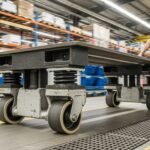Key Takeaways
- Material handling efficiency has a direct impact on productivity, costs, and safety in industrial and logistics environments.
- Specialized casters, such as suspension casters, offer key benefits like shock absorption, floor protection, and easier maneuverability of heavy loads.
- Investing in high-quality casters can lead to measurable reductions in maintenance, decreased worker fatigue, and improved asset longevity.
- Strategic selection and ongoing maintenance of casters are vital to achieving the best return on investment and ensuring smooth operations.
Why Material Handling Efficiency Matters
In today’s fast-paced manufacturing, warehousing, and logistics environments, operational efficiency is critical to staying competitive and profitable. Every piece of equipment, from forklifts to conveyor belts, plays an important part. Even the smallest components, such as the wheels that carts and machinery move on, can have a dramatic impact on workflow speed, labor hours, and overall output. Research indicates that maximizing the smooth flow of goods and materials within a facility can drive productivity gains of up to 25%. For many businesses, investing in upgraded suspension casters quickly proves to be a wise decision that pays significant dividends by reducing physical resistance, equipment downtime, and even employee injuries.
While the focus often stays on significant capital investments, industry leaders who pay attention to detail find that a comprehensive approach yields the best results. Upgrades that appear minor—such as changing out outdated caster wheels—help eliminate micro-delays caused by stoppages, vibrations, or maneuverability issues. In facilities pushing for leaner operations, every efficiency counts. As more operations look for ways to do more with less, the right caster can help bridge the gap between optimal performance and unnecessary friction.
The Science Behind Suspension Casters
The technology behind suspension casters lies in their ability to distribute weight evenly, absorb shock, and reduce vibrations even under the heaviest loads. Unlike traditional casters, suspension casters employ built-in shock-absorbing systems—often using heavy-duty springs, advanced polymers, or other specialized materials—to minimize the transfer of force from the floor to the load. This keeps goods stable and protects delicate components during movement, even over rough surfaces or flooring transitions.
When moving industrial equipment or sensitive electronics, the unique capability of suspension casters to absorb bumps and shocks leads to fewer mishaps, less product damage, and a lower risk of jarring impacts that could cause internal harm to the transported equipment. This technological sophistication makes them a superior choice for demanding, high-mix environments where every load—large or small—needs reliable, stable transit.
Key Features That Improve Performance
Several essential features allow suspension casters to stand apart and provide genuine operational benefits:
- Durable Wheel Materials: Wheels crafted from specialized compounds or reinforced materials handle abrasive surfaces and heavy weights without wearing prematurely.
- Integrated Shock Absorption: Mechanisms such as steel springs or resilient polymers cushion loads, allowing for the safe transportation of sensitive products alongside robust ones.
- Low-Vibration Movement: Minimizes the strain on both carried items and users, offering smoother operation that significantly reduces jostling and the associated risk of tipping or mishandling.
- Swivel and Locking Options: Enhanced maneuverability is crucial in tight spaces or areas with heavy traffic, allowing for agile turns or steady, controlled stops as required.
Judicious selection of features based on the facility’s specific applications ensures carts and mobile equipment glide effortlessly, maximizing throughput without compromising safety or the working environment. The right combination of engineering and materials yields casters that not only facilitate quick handling but also withstand the demands of a busy industrial setting for months or even years.
How to Choose the Best Suspension Casters for Your Needs
Choosing the best caster for an application starts with asking the right questions. Begin by accurately determining typical and peak load weights to ensure every caster in use is adequately rated. Floor surface is a close second in importance, as a caster suited for concrete may not perform as well on tile or carpet. For a helpful overview of caster types, materials, and mounting options, the article “Roll Models” from Wood Magazine offers practical insights that can further inform your choices. Next, environmental considerations, such as temperature extremes, exposure to oils, or ambient humidity, may dictate the use of specific materials or protective features.
Finally, please don’t overlook the layout and demands of the facility itself: for highly dynamic spaces or those requiring movement through narrow aisles and around sharp corners, prioritize casters with excellent swivel capabilities, ergonomic design, and locking mechanisms for stability on ramps or inclines. Following these decision points ensures tailored solutions and greater reliability for years to come.
Maintenance Tips to Extend Caster Lifespan
Suspension casters, like all mechanical systems, perform best with proactive and consistent maintenance. Regular visual inspections enable teams to identify issues—such as debris or tangled strapping—before they lead to misalignment or excessive wear. Lubricating the wheel and swivel bearings periodically keeps motion effortless and prevents squeaks that often signal breakdowns. Springs and other shock-absorbing systems should be checked for signs of fatigue, which can occur more quickly in high-usage environments.
Lastly, ensure mounting bolts and hardware remain tight. Vibration and repeated use can loosen parts over time, compromising caster performance and equipment stability. Incorporating these quick checks into daily or weekly preventive maintenance routines helps avoid unexpected equipment failures and saves both money and time on emergency repairs.
Getting More from Your Equipment
Upgrading to thoughtfully selected suspension casters is a straightforward change that delivers outsized benefits. Businesses that make this switch often see reductions in operator fatigue, extended equipment life, and consistently high material flow efficiency. Regular inspection and personalized selection of casters ensure maximal reliability, minimized disruptions, and better outcomes for every dollar spent. Although small in appearance, the right casters can fundamentally improve not only productivity but also workplace quality and employee satisfaction.
For those aiming to future-proof their facilities, investing in casters designed for modern, automated, and ergonomic demands is a proactive way to stay ahead of challenges. Businesses willing to look “under the hood” and upgrade seemingly simple components are the ones most likely to keep their edge as material handling grows smarter, safer, and more efficient.
Read More : Personalized Hair Removal: Science-Backed Strategies for Lasting Results





